Milstar-1 1, 2 (Milstar 1, 2) (original) (raw)

Milstar-1 [USAF]
Milstar (Military Strategic & Tactical Relay), DFS (Development Flight Satellite) is the tactical and strategic multiservice satellite system designed to provide survivable communications for U.S. forces worldwide. The program is managed by the U.S. Air Force Space and Missile Center.
The Milstar-1 satellites carry a secure, robust low-data-rate (LDR) communications payload, and a crosslink payload that allows the satellites to communicate globally without using a ground station. The Milstar-2 satellites extend the communications capabilities to higher data rates by adding a medium-data-rate (MDR) payload. The Milstar-1 and Milstar-2 satellites are fully interoperable for LDR communications and crosslinks.
Milstar satellites use a unique bus, consisting of three boxes, which are folded during launch and deploy in orbit.
The Milstar system provides uplink communications at extremely high frequency (EHF), 44 GHz, and ultrahigh frequency (UHF), 300 MHz, and downlink communications at super-high frequency (SHF), 20 GHz, and UHF, 250 MHz. The crosslinks operate in the 60 GHz region. Survivability and endurability requirements are satisfied by anti-jam, hardening and system autonomy features.
- LDR Payload:
The LDR payload offers nearly 200 user channels and relays coded teletype and voice messages at data rates of 75 to 2400 bits per second. - Crosslink Payload:
Like a handshake in space, crosslinks provide rapid, ultra-secure communications by enabling the satellites to pass signals to one another worldwide while requiring only one ground station on friendly soil. The crosslink payload provides V-band (60 GHz) data communications between Milstar satellites for both the MDR and LDR payloads. This includes modulation and demodulation of the data, upconversion, amplification for transmission and downconversion.
Both Block I satellites were still operational as of August 2016, over 20 years since they were launched.